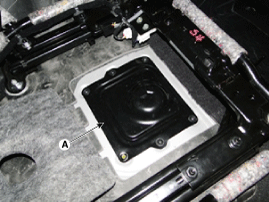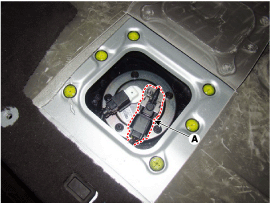Hyundai Genesis: Engine Control System / Fuel Tank Pressure Sensor (FTPS) Repair procedures
Hyundai Genesis (DH) 2013-2016 Service Manual / Engine Control / Fuel System / Engine Control System / Fuel Tank Pressure Sensor (FTPS) Repair procedures
| Inspection |
| 1. |
Connect the GDS on the Data Link Connector (DLC ). |
| 2. |
Measure the output voltage of the FTPS.
|
| Removal |
| 1. |
Turn the ignition switch OFF and disconnect the negative (-) battery cable. |
| 2. |
Fold the rear seat cushion. |
| 3. |
Remove the sub fuel sender service cover (A) after removing installation screw.
|
| 4. |
Disconnect the fuel tank pressure sensor connector (A). |
| 5. |
Remove the fuel tank pressure sensor from the sub fuel sender after loosening nut.
|
| Installation |
|
|
| 1. |
To install, reverse the removal procedure. |
 Fuel Tank Pressure Sensor (FTPS) Schematic Diagrams
Fuel Tank Pressure Sensor (FTPS) Schematic Diagrams
Circuit Diagram
...
 Injector Description and Operation
Injector Description and Operation
Description
Based on information from various sensors, the ECM can
calculate the fuel amount to be injected. The fuel injector is a
solenoid-operated valve and the fuel injection amount is cont ...
Other information:
Hyundai Genesis (DH) 2013-2016 Service Manual: Drive Belt Tensioner Repair procedures
Removal and Installation 1. Remove the drive belt. (Refer to Timing System - "Drive Belt") 2. Remove the drive belt auto tensioner (A). Tightening torque Bolt (B) : 81.4 ~ 85.3 N.m (8.3 ~ 8.7 kgf.m, 60.0 ~ 62.9 lb-ft) Bolt (C) : 17.7 ~ 21.6 N.m (1.8 ~ 2.2 kgf.m, 13.0 ~ 15.9 b-ft) ...
Hyundai Genesis (DH) 2013-2016 Service Manual: A/C Pressure Transducer Description and Operation
Description The A/C Pressure Transducer (APT) converts the pressure value of high-pressure line into voltage value after measuring it. By converted voltage value, engine ECU controls the cooling fan by operating it at high speed or low speed. Engine ECU stops the operation of the compress ...
© 2013-2025 www.hgenesisdh.com



